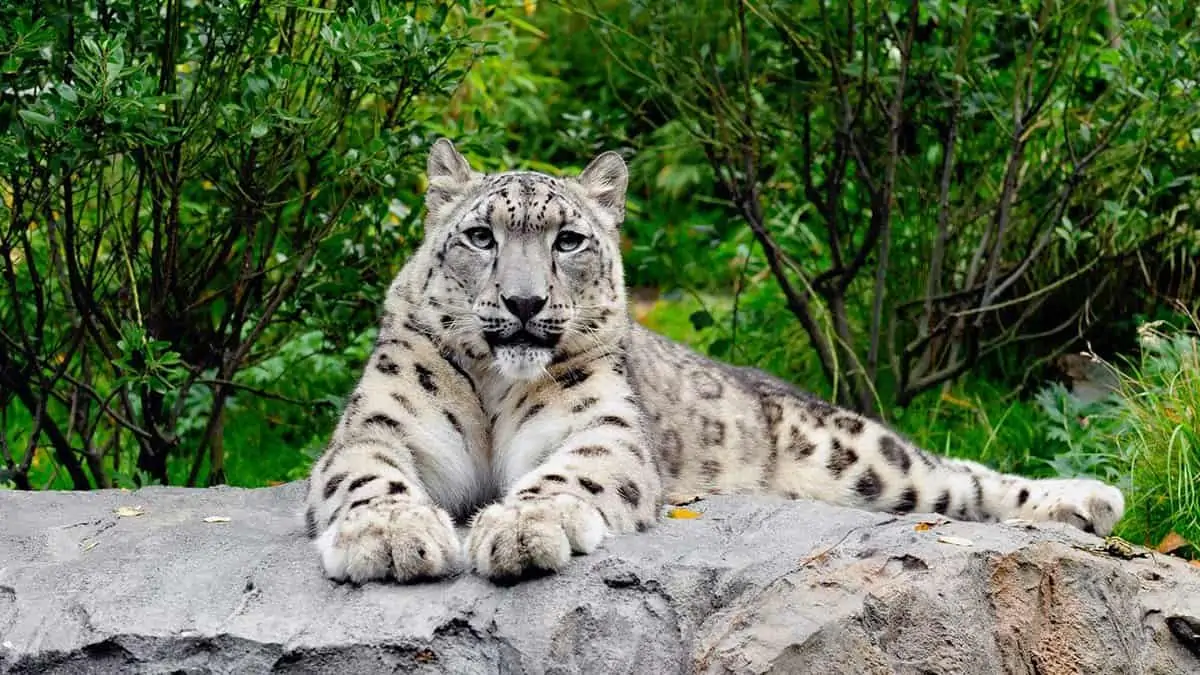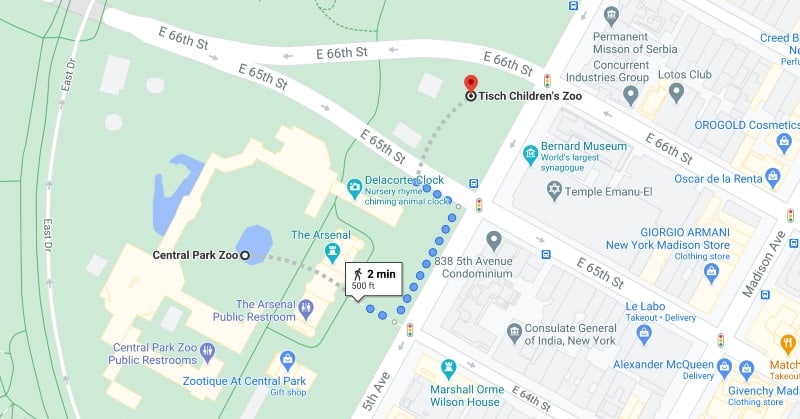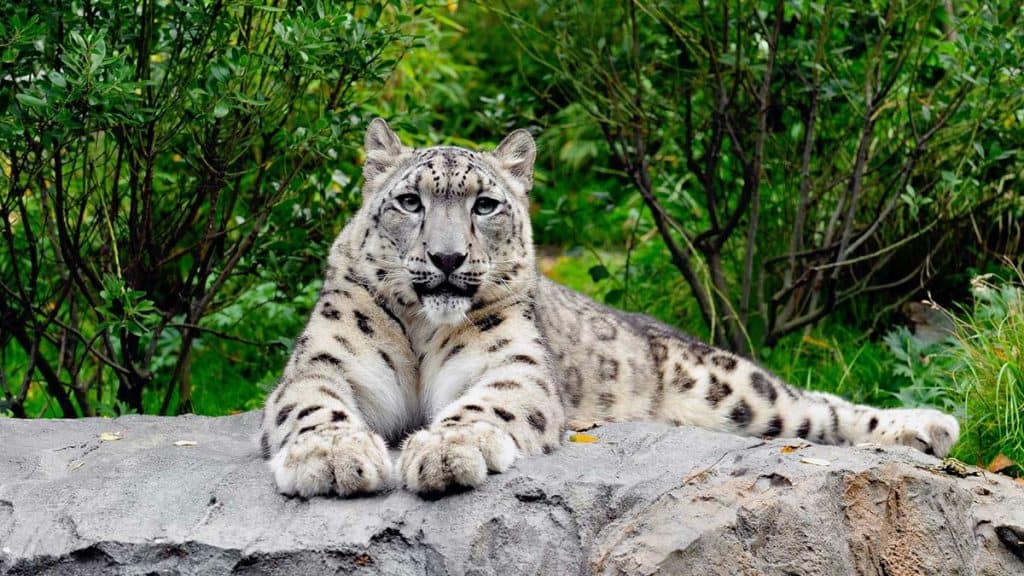
The Central Park Zoo is a popular tourist destination tucked inside the lush Central Park in New York City.
Spread across 6.5 acres, it is an apt choice for a quick outing, especially for families with children.
One of the oldest zoos in the country, Manhattan’s Central Park Zoo may be small, but draws over one million visitors annually.
This article covers everything you must know before booking tickets for the Central Park Zoo.
Top Central Park Zoo Ticket
Table of Contents
What to expect
Get up close and personal with some exotic wildlife at the Central Park Zoo.
Despite its small size, this charming and intimate attraction is home to a variety of fascinating creatures, such as grizzly bears, snow leopards, sea lions, penguins, red pandas, and more.
Watch the penguins and tufted puffins waddle around and snatch fish out of the air while next door, the sea lions put on an aquatic acrobatics show in the Polar Circle.
Discover tree snakes, ruffed lemurs, and dart frogs in the lush tropical canopy, or explore the temperate zone, home to red pandas and snow monkeys from Asia.
Time your visit during feeding times to see penguins and the mesmerizing acrobatics of the sea lions as they swim and dive!
Buy This TicketWhere to book tickets
Tickets for the Central Park Zoo are available to be purchased at the zoo or online in advance.
Online ticket prices tend to be cheaper than tickets at the attraction.
When you buy online, you can avoid the long queues at the attraction’s ticket counters.
Since these tickets are timed, booking online also helps you get your preferred time slots.
How do online tickets work
Go to the Central Park Zoo ticket booking page, select your preferred date, time slot and the number of tickets, and buy the tickets right away.
After the purchase, you will receive the tickets via email.
You don’t need to carry printouts.
You can show the e-ticket on your smartphone when you visit the attraction and exchange it for a Garden Pass admission at the Visitor Center.
Central Park Zoo tickets prices
Adult tickets for the Central Park Zoo can be booked for US$20 for visitors over 13 years of age.
For children between three to 12 years, tickets are available for US$15.
Infants under three years of age can get in for free.
Discounted tickets are available on-site for individuals aged 65 and above.
Madagascar, the 2005 animated movie where four animals escape a zoo and get shipwrecked on Madagascar island, is set in Central Park Zoo.
Tickets for Central Park Zoo: Total Experience
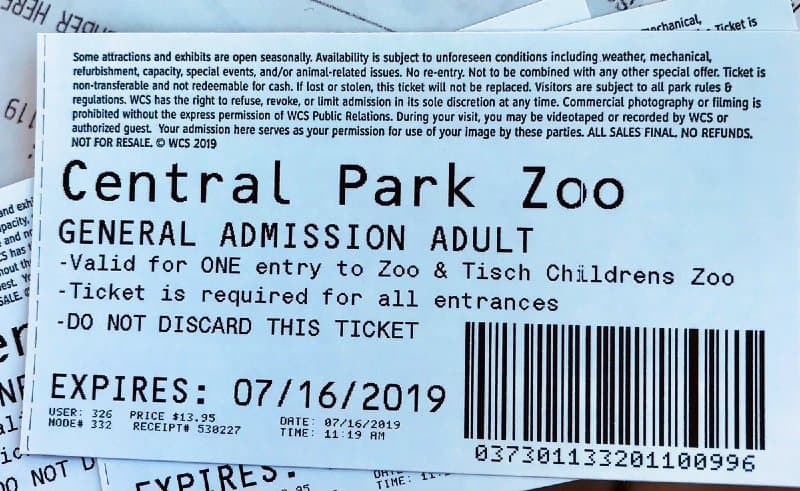
Get ready for an unforgettable adventure in the heart of New York City with a visit to the Central Park Zoo!
Visitors purchasing tickets for the Central Park Zoo will have access to the main zoo, Tisch Children’s Zoo, and one visit to the 4-D Theater.
Get an opportunity to explore three unique environments at your own pace: Polar Circle, Tropic Zone, and Temperate Territory.
This ticket offers express entry to the zoo, allowing you to bypass waiting in long lines and save time.
Ticket price
Adult ticket (13+ years): $20
Child ticket (3 to 12 years): $15
Infant Ticket (up to 2 years): Free
Yet to decide? Check out the best wildlife attractions in New York.
How to reach Central Park Zoo
Central Park Zoo is located in the southeastern corner of Central Park, New York City.
Address: East 64th Street, New York, NY 10021, United States. Get Directions
By Bus
The nearest bus stop to the Central Park Zoo is 5 Ave/E 63 St, which can be reached by buses M1, M2, M3, or M4.
By Subway
Travel on N, R, or W Trains to the Fifth Avenue station on 59th Street in Manhattan to reach the Central Park Zoo.
By Car
If you are driving by car, turn on Google Maps and get started!
Choose between a host of parking options around the zoo or reserve your parking spot near the destination through SpotHero.
Timing of Central Park Zoo
The Central Park Zoo is open every day from 10 am to 4.30 pm between November and March.
During the rest of the year, the zoo is open from 10 am to 5 pm on weekdays and from 10 am to 5.30 pm on weekends and public holidays.
Entry to the zoo is restricted one hour before closing, whereas all animal exhibits close 30 minutes before closing time.
How long does the Central Park Zoo experience take
Visitors spend around 60 to 90 minutes exploring the Central Park Zoo.
However, visitors are free to stay as long as they want since the zoo tickets are not timed.
Best time to visit Central Park Zoo
For a more enjoyable visit, it is best to book your tour on a weekday when the zoo is less busy.
If you want to avoid the crowds, we recommend arriving at the zoo right when it opens at 10 am.
The animals are most active in the morning, and the crowds and queues are smaller.
Weekends and public holidays tend to be the most crowded time at the zoo.
Animals at Central Park Zoo
Central Park Zoo offers exciting experiences along with animal viewing.
It has three significant habitats – the Polar Circle, Temperate Territory, and Tropical Rainforests.
Polar Circle
The Polar Circle exhibit is similar to the natural conditions penguins experience in the wild.
The habitat’s temperature is maintained between 0 and 1 degrees Celcius (32 to 34 degrees Fahrenheit), and the water temperature remains at 5.5 degrees Celcius (42 degrees Fahrenheit).
Five penguin species on display at Polar Circle are the Tufted Penguin, Gentoo Penguin, King Penguin, Chinstrap Penguin, and Macaroni Penguin.
Penguin feeding happens twice a day – at 10.30 am and 2.30 pm.
It is one of the most popular exhibits at the Central Park Zoo in New York.
Tropic Zone – the Rainforest
The Tropic Zone in the Central Park Zoo is a sky-lit enclosure containing dense vegetation, a waterfall, lots of primates, and tropical birds flying freely about an open aviary.
It houses an incredible variety of species, including magnificent birds with brilliant colors.
The African Pygmy Goose and the Scarlet-Chest Parrot amongst them are crowd favorites.
You can also see lots of frogs, lizards, snakes, toads, Black and White Ruffed Lemurs, and Tamarins in this habitat.
Temperate Territory
The Temperate Territory in the Central Park Zoo has several species from Asia.
This habitat is home to yet another visitor favorite – Sea Lion Pool.
When you spot the row of columns, take the landscaped path to its West to see the island that is home to a clan of Japanese snow monkeys.
Paths further West take you to Asian Red Pandas, North American River Otters, Mandarin Ducks, Red Swans, etc.
Snow Leopards
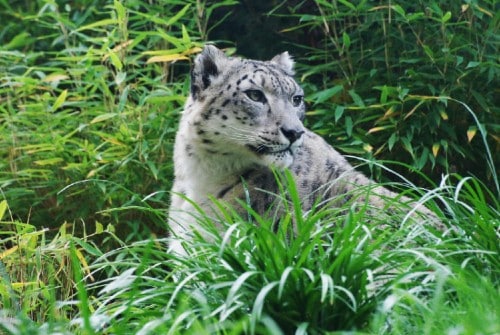
The Allison Maher Stern Snow Leopard exhibit is like the scrubby evergreen forests in Central Asia’s mountainous region, where the highly endangered snow leopard lives.
They are in the topmost portion of the temperate zone, north of the Red Pandas.
Image: Centralpark.com
The exciting part is that you can go nose-to-nose with these felines and see them perched on rocks and boulders.
Central Park Zoo in New York is home to male and female Snow Leopard twins River and Summit (born 2 June 2013).
They live in one habitat along with their mother’s other younger cub, Malala (born in 2014).
It is a delight to watch these impressive animals navigate steep terrain with grace.
Sea Lion Pool
The massive Sea Lion Pool in the Temperate Zone in the Central Garden is home to three female California Sea Lions – April, Charlotte, and Margaretta.
The sea lions sunning on rocks against the Manhattan skyline cut quite a picture in the Central Park Zoo in New York.
The exhibit features both above and below-water viewing.
If you go around feeding times – 11.30 am, 1.30 pm, and 3.30 pm – you can see these creatures devour enormous amounts of fish.
Grizzly Bear & Treena’s Overlook
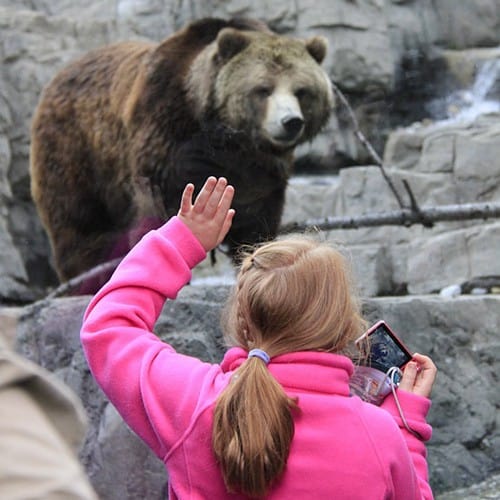
Betty and Veronica are the two grizzly bears that live in Central Park Zoo.
The two female grizzlies came from the Bronx Zoo after being rescued in 1995 from Montana and Yellowstone National Park.
The space they now live in was previously home to the late polar bears Gus and Ida.
Image: Centralparkzoo.com
Treena’s Overlook also offers visitors an opportunity to learn how people can better co-exist with bears in the wild.
Tisch Children’s Zoo
The Tisch Children’s Zoo is just across 65th Street from the Central Park Zoo.
Central Park Zoo ticket includes entry to the children’s zoo even though it is outside the main premises.
Tisch Children’s Zoo has farm animals such as sheep, goats, pigs, zebu, rabbits, turtles, and waterfowl.
Visitors can avail food from the food dispensers and feed them between 10 am and 2 pm.
Next to the animal pens, the bronze statues replicate the animal’s sound on touch, thereby entertaining and educating the young visitors.
The Tisch Children’s Zoo is home to the only cow in Manhattan.
Animal feeding at Central Park Zoo
Animal feeding sessions at the Central Park Zoo can be fun and insightful.
The Central Park Zoo has two animal feeding experiences worth viewing: sea lions and penguins.
The regular Central Park Zoo entry ticket to the zoo includes animal feeding sessions.
Sea Lion feeding
Sea Lions are active and at their playful best during feeding sessions at the Central Park Zoo.
Adult California Sea Lions can eat 15-40 lbs. of fish and marine life a day.
The animals are fed Capelin, Herring, Vitamin E, and salt supplements at the Central Park Zoo.
Sea Lion feeding coincides with behavioral enrichment and training three times a day at 11.30 am, 1.30 pm, and 3.30 pm.
Penguin feeding
Penguins at the Central Park Zoo are out and about when it is feeding time.
In the wild, Penguins eat fish and krill, a shrimp-like crustacean.
At the Central Park Zoo in New York, their diet consists of Capelin (a type of smelt) and Herring.
The King Penguin prefers feeding on fish and squid rather than the crustaceans.
The Penguins are hand-fed by keepers twice a day – at 10.30 am and 2.30 pm.
4-D Theatre at Central Park Zoo
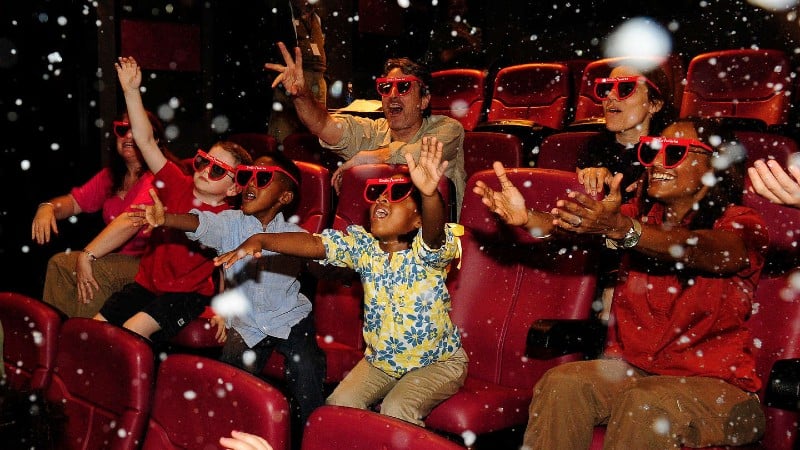
Central Park Zoo ticket includes admission to the 4-D theatre experience inside the zoo.
It is an immersive exhibit featuring the visual drama of a 3-D film with a variety of built-in sensory effects like mist, air blasts, bubbles, leg ticklers, and scents.
All visitors get clean 3-D glasses before every show.
Map of Central Park Zoo
Even though it is a small zoo, it is wiser to have a copy of the Central Park Zoo’s map to navigate the various exhibits.
A map can help you locate animal enclosures and visitor facilities such as restrooms, restaurants, baby changing facilities, medical rooms, souvenir shops, etc.
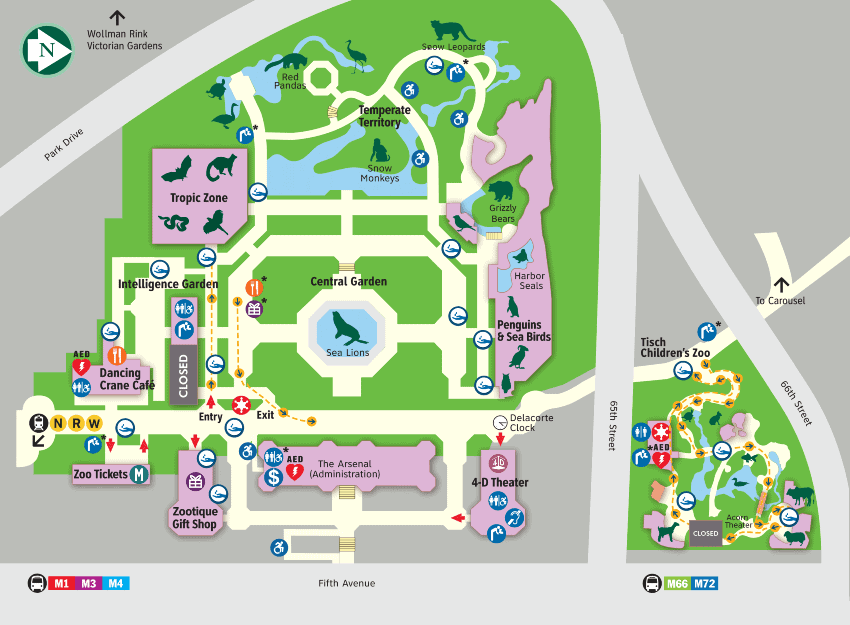
Carrying the Central Park Zoo’s layout is highly recommended if you are traveling with kids because you won’t waste time finding the various exhibits and get exhausted in the process.
You can download and print the zoo map here.
Food at Central Park Zoo
The Central Park Zoo’s Dancing Crane Café serves a wide variety of high-quality meals, snacks, beverages, and desserts.
The café prides itself on its carefully prepared, fresh, and healthy meal choices.
There are food and drink vendors located throughout the zoo if you want a quick bite or beverage.
If you are carrying food from home, benches outside the Central Park Zoo make ideal picnic spots.
Visiting Central Park Zoo in winter
The Central Park Zoo in New York is open 365 days a year, with animals on exhibit all year round.
Spring and Summer are popular seasons to visit.
Still, fall and winter can be equally exciting times to explore the Central Park Zoo.
For one, the crowds are comparatively fewer.
Sometimes, it is an experience to watch animals adapt to their habitats when it snows.
Many animals are more active during the winter months, including the Snow Leopards, Grizzly Bears, Red Pandas, and Sea Lions.
Other interesting species are the Japanese Macaques. Their habitat includes winter hot tubs that reach the same temperature as their body temperature – 104 degrees, for their bathing pleasure.
Then there are Snow Monkeys- native to parts of Japan where it snows.
These monkeys are thought to have inspired the famous saying – see no evil, hear no evil, and speak no evil.
FAQs for the Central Park Zoo
What does the Central Park Zoo ticket include?
The Central Park Zoo ticket includes entrance to the Main and Tisch Children’s Zoo and one visit to the 4-D Theatre.
What animals can be found at the Central Park Zoo?
The zoo is home to a variety of animals from different parts of the world, including snow leopards, grizzly bears, penguins, sea lions, red pandas, and many more.
Should I buy tickets for the Central Park online?
It is best to book online tickets in advance to ensure you get your preferred time slot and save money.
Can I carry my own food into the Central Park Zoo?
Visitors are permitted to bring their own food to the zoo. There are several benches available outside of the zoo or in the park, which make for ideal picnic spots. If you prefer not to carry your food, the Dancing Crane Café at the zoo offers a wide range of high-quality meals, snacks, beverages, and desserts. The café is known for its carefully prepared, fresh, and healthy choices.
Is the Central Park Zoo wheelchair accessible?
Yes, the zoo is wheelchair accessible and offers wheelchair rentals on a first-come, first-served basis at the ticket counter.
Are strollers allowed inside the Central Park Zoo?
Yes, visitors are allowed to bring strollers inside the zoo. However, you may be asked to park your stroller in a designated area before entering some buildings and exhibits.
Is photography allowed at the Central Park Zoo?
Yes, photography is allowed at the zoo, but flash photography is prohibited in certain exhibits.
Can I bring my pet to the Central Park Zoo?
No, pets are not allowed inside the zoo, with the exception of service animals.
Is there a gift shop at the Central Park Zoo?
Visitors can shop for unique and wild items at the Zootique, including plush animals, children’s books, toys, and games.
Other Zoos in New York
